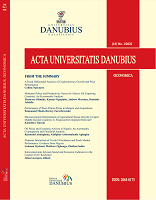Assessing the Inflation Targeting in Uganda through Taylor Rule. Evidence from the ARDL Model
Assessing the Inflation Targeting in Uganda through Taylor Rule. Evidence from the ARDL Model
Author(s): Mbongeni Zwelakhe Ngubane, Syabonga Mndebele, Kehinde Damilola IlesamniSubject(s): National Economy, Business Economy / Management, Economic policy, Financial Markets
Published by: Editura Universitară Danubius
Keywords: ARDL model; Taylor rule; inflation targeting;
Summary/Abstract: The inflation targeting lite in Uganda has received considerable attention in the literature. However, the central bank of Uganda has chosen to target the core inflation rather than headline inflation which involves the consumer price that highly affects the society at large. On the other hand, the central bank plays a game of fear of float in times of high exchange rate volatility. Given the fact that the central bank reaction function of the central bank has limited evidence, this study undertakes the augmented Taylor rule regressed through the autoregressive distributed lads (ARDL) model to analyze if Taylor rule can predict the central bank of Uganda (CBU). The findings of the study indicate that the Taylor rule is a good predictor of monetary policy in Uganda. The first Taylor principle hold since the inflation coefficient is positive and statistically different from one. The second Taylor principle does not hold since the output gap is negative and insignificant. Lastly, the exchange rate is positive and significant to indicate that CBU intervenes in the exchange rates markets. The study indicates that formal inflation targeting can be effective policy in Uganda.
Journal: Acta Universitatis Danubius. Œconomica
- Issue Year: 19/2023
- Issue No: 1
- Page Range: 7-23
- Page Count: 17
- Language: English

